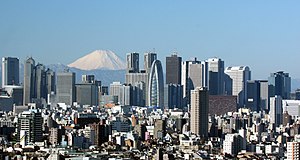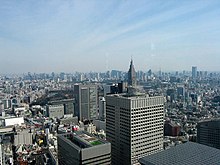|
|
|---|
Thursday, October 21, 2010
List of metropolitan areas by population, populous and largest city in the world
Posted by pece at 6:19 AMList of metropolitan areas by population
A list of world city population for all the largest cities in the world. Find the population of Mexico City, Tokyo, or Shanghai China.

Tokyo, the most populous metropolitan area in the world
One concept which measures the world's largest cities is that of the metropolitan area, which is based on the concept of a labor market area and is typically defined as an employment core (an area with a high density of available jobs) and the surrounding areas that have strong commuting ties to the core. There is currently no generally accepted, globally consistent definition of exactly what constitutes a metropolitan area, thus making comparisons between cities in different countries especially difficult.
One attempt at arriving at a consistently defined metropolitan area concept is the study by Richard Forstall, Richard Greene, and James Pick. The basic principles of their definition involve delineating the urban area as the core, then adding surrounding communities that meet two criteria: (1) Less than 35% of the resident workforce must be engaged in agriculture or fishing; and (2) At least 20% of the working residents commute to the urban core.
Based on their consistently defined metropolitan area criteria, they tabulate a list of the twenty largest metropolitan areas in 2003. As population figures are interpreted and presented differently according to different methods of data collection, definitions and sources, these numbers should be viewed as approximate. Data from other sources may be equally valid but differ due to being measured according to different criteria or taken from different census years.
Rank | Metropolitan area | Country | Population | Area (km2) | Population Density (People/km2) | ||
|---|---|---|---|---|---|---|---|
| 1 | Tokyo | 32,450,000 | 8,014 | 4,049 | |||
| 2 | Seoul | 20,550,000 | 5,076 | 4,048 | |||
| 3 | Mexico City | 20,450,000 | 7,346 | 2,784 | |||
| 4 | New York City | 19,750,000 | 17,884 | 1,104 | |||
| 5 | Mumbai | 19,200,000 | 2,350 | 8,170 | |||
World's largest cities-
The question of determining the world's largest cities does not allow a single, simple answer. It depends on which definitions of "city" and "size" are used, and how those definitions are applied. Complex political/cultural/social situations, sometimes controversial or disputed, further confuse the discussion. Debate on this field is highly vulnerable to bias or manipulation, as people tend to prefer whichever definition most flatters their own city.
The "size" of a city can refer to either its land area or, more typically, its population.
The boundaries of a city can also be defined in any of several ways:
One concept which measures the world's largest cities is that of the metropolitan area, which is based on the concept of a labor market area.
World's Largest Cities [Ranked by City Population]. A list of the largest cities by population - rank 1-1000. Sort by:Urban Area Population,
A list of the biggest cities in the world. Also largest countries by population and land mass and other interesting facts.
This entry tracks and ranks the population of the largest cities in the United States by decade, starting with the 1790 Census. For 1790 through 1990,
List of United States cities by population-

Ten most populous cities in the United States
(2) Los Angeles
(10) San Jose
(8) San Diego
(5) Phoenix
(3) Chicago
(1) New York City
(4) Houston
(7) San Antonio
(9) Dallas
(6) Philadelphia
The following is a list of the most populous incorporated places in the United States. As defined by the United States Census Bureau, an "incorporated place" includes a variety of designations, including a city, town, village, borough, and municipality.
Some census-designated places may also be included in the Census Bureau's listing of incorporated places. Consolidated city-counties represent a distinct type of government that includes the entire population of a county, or county equivalent. Some consolidated city-counties, however, include multiple incorporated places. This list presents only that portion (or "balance") of such consolidated city-counties that are not a part of another incorporated place.
Note that this list refers only to the population of individual municipalities within their defined limits, which does not include other municipalities or unincorporated suburban areas within urban agglomerations. A different ranking is evident when considering U.S. metropolitan area populations.
Incorporated places over 100,000 population-
 1: New York, New York  2: Los Angeles, California  3: Chicago, Illinois  4: Houston, Texas  5: Phoenix, Arizona  6: Philadelphia, Pennsylvania  7: San Antonio, Texas  8 – San Diego, California  9 – Dallas, Texas  10 – San Jose, California  11 – Detroit, Michigan 12 – San Francisco, California 13 – Jacksonville, Florida 14 – Indianapolis, Indiana 15 – Austin, Texas 16 – Columbus, Ohio 17 – Fort Worth, Texas 18 – Charlotte, North Carolina 19 – Memphis, Tennessee 20 – Boston, Massachusetts 21 – Baltimore, Maryland 22 – El Paso, Texas 23 – Seattle, Washington 24 – Denver, Colorado 25 – Nashville, Tennessee 26 – Milwaukee, Wisconsin 27 – Washington, D.C. 28 – Las Vegas, Nevada 29 – Louisville, Kentucky 30 – Portland, Oregon 31 – Oklahoma City, Oklahoma 32 - Tucson, Arizona  33 – Atlanta, Georgia 34 – Albuquerque, New Mexico 35 – Kansas City, Missouri 36 – Fresno, California 37 – Mesa, Arizona 38 – Sacramento, California 39 – Long Beach, California 40 – Omaha, Nebraska 41 – Virginia Beach, Virginia 42 – Miami, Florida 43 – Cleveland, Ohio 44 – Oakland, California 45 – Raleigh, North Carolina 46 – Colorado Springs, Colorado 47 – Tulsa, Oklahoma 48 – Minneapolis, Minnesota 49 – Arlington, Texas 50 – Honolulu, Hawaii |
The following table lists the incorporated places in the United States with a population on July 1, 2009, of more than 100,000 as estimated by the United States Census Bureau. Population densities are also given by the U.S. Census Bureau, but are listed as of the 2000 U.S. Census.
Since the U.S. Census Bureau typically does not rank the cities of U.S. territories along with those of the fifty states and the District of Columbia, the cities of Puerto Rico with populations greater than 100,000 are listed separately below.
Largest cities in the United States by population by decade · List of cities proper by population (most populous cities in the World); List of cities,
The table below lists the largest 50 cities in the United States based on .... Profiles of the 50 Largest Cities of the United States - Profiles of the 50
Related content from HighBeam Research on: Profiles of the 50 Largest Cities of the United States. CONOCOPHILLIPS PROFILE (Renewable Fuel News)
These tables feature the largest metropolitan areas in the United States, the largest metropolitan areas in the World and the largest cities in the World.
Top 100 biggest cities. New! We added hundreds of new lists - see our top 101 city lists. Also check out our website just for ranking top lists with best regards.
United States map with major cities is a good resource to get hands on at the information related to states of US, their respective capitals
The United States of America is a country in North America. ... US Census figures for the biggest cities, 2002: Population Estimates for Incorporated Places
Largest Cities in the United States - by Population, cities, population, statistics, localities, towns, inhabitants, major cities, principal cities,
One of the biggest cities in the world! Buenos Aires is the capital, and largest city, of Argentina, currently the second-largest.
Θεσσαλονίκη is the second-largest city in Greece and the capital of Macedonia, the nation's largest region. It is the largest city in the world.
Panoramic photo by Lee Casalena . Construction of the World's Largest Frying Pan, used to break the Guinness World Record
Esfahān or Isfahan (historically also rendered as Ispahan or Hispahan, Old Persian: Aspadana, Middle Persian: Spahān, Persian: اصفهان
Moscow has scored 25th in the new rating of the most attractive cities in the world, drawn up by Foreign Policy Magazine.
Thu, Sep 16: Two of Canada's largest cities have been ranked among the most pricey places to live in the world.
City-
For other uses, see City (disambiguation).

Tokyo, the most populous metropolis in the world

Seoul, the second most populous metropolis in the world

Shanghai is the most populous city proper in the world.
A city is a relatively large and permanent settlement. Although there is no agreement on how a city is distinguished from a town within general English language meanings, many cities have a particular administrative, legal, or historical status based on local law.
For example, an article of incorporation approved by the local state legislature distinguishes a city government from a town in Massachusetts. In the United Kingdom and parts of the Commonwealth of Nations, a city is traditionally a settlement with a royal charter. Historically, in Europe, a city was understood to be an urban settlement with a cathedral.
Cities generally have advanced systems for sanitation, utilities, land usage, housing, and transportation. The concentration of development greatly facilitates interaction between people and businesses, benefiting both parties in the process. A big city or metropolis usually has associated suburbs and exurbs. Such cities are usually associated with metropolitan areas and urban sprawl, creating numerous business commuters traveling to urban centers of employment. Once a city sprawls far enough to reach another city, this region can be deemed a conurbation or megalopolis.
From Wikipedia-
0 Comments:
Subscribe to:
Post Comments (Atom)















